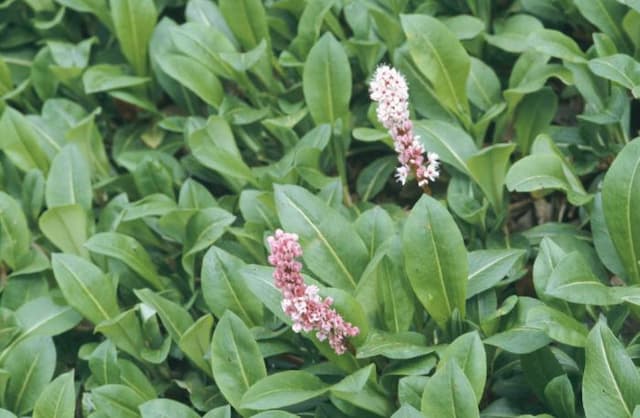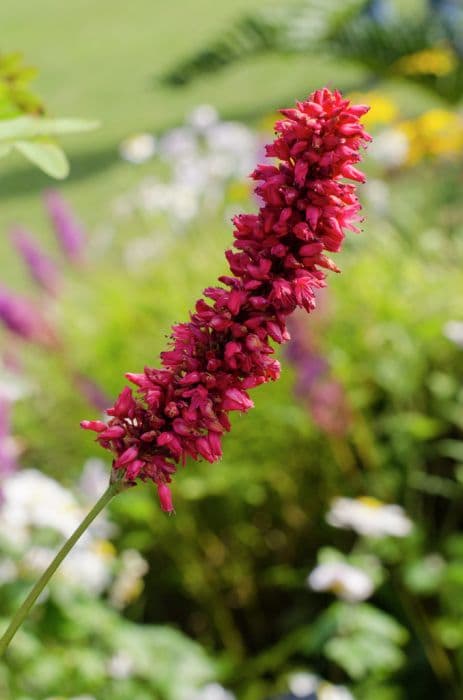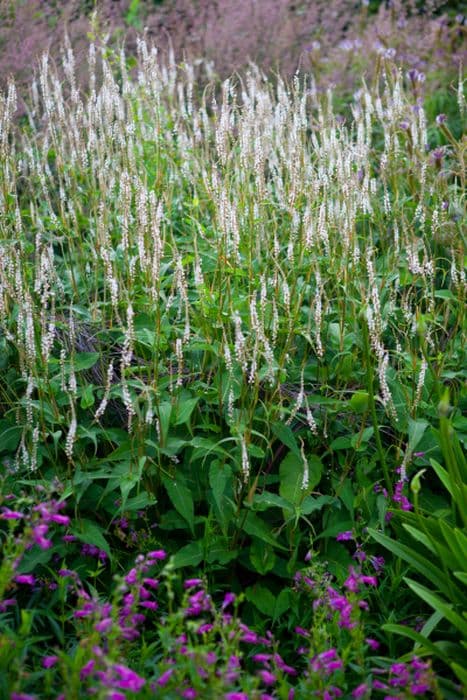Himalayan Bistort Persicaria affinis 'Donald Lowndes'

ABOUT
The plant known as 'Donald Lowndes' is a flowering perennial that is characterized by its spreading nature. It has a dense mat of small, narrow leaves that are a deep green color with a slightly bronzy hue. The foliage tends to exhibit a more intense reddish bronze during the colder months, adding to its visual interest throughout the year. Flowering from midsummer to fall, 'Donald Lowndes' is adorned with an abundance of spikes carrying tiny, densely packed blossoms. These flowers start out a delicate pink shade and gradually deepen to a rich cerise as they mature, offering a two-toned effect on the plant at any given time due to the staggered flowering stages. The ground-hugging nature of this plant makes it ideal for rock gardens, border fronts, or as a colorful ground cover. Its creeping stems root at the nodes where they come into contact with the soil, enabling the plant to spread effectively. It is a low-maintenance choice for the garden, providing a long season of interest without needing much care.
About this plant
 Names
NamesFamily
Polygonaceae.
Synonyms
Himalayan Bistort, Fleeceflower, Knotweed.
Common names
Polygonum affine, Bistorta affinis, Persicaria campanulata.
 Toxicity
ToxicityTo humans
Persicaria affinis 'Donald Lowndes', commonly known as Himalayan bistort, is not widely reported as being toxic to humans. There is limited information available on the toxicity of this specific cultivar. However, as with many plants, it may cause stomach upset or allergic reactions in some individuals if ingested. To ensure safety, it is generally recommended that no part of the plant should be eaten by humans. In cases where accidental ingestion occurs, monitoring for any adverse reactions and seeking medical advice would be prudent.
To pets
Himalayan bistort is not regularly cited as a toxic plant to pets. As with its toxicity to humans, there is limited specific information on the toxicity of Persicaria affinis 'Donald Lowndes' to pets. Nevertheless, it is advisable to prevent pets from ingesting the plant. While it may not be severely poisonous, it could potentially cause mild gastrointestinal upset or an allergic response. If a pet consumes a part of the plant and shows any signs of distress, contacting a veterinarian is recommended.
 Characteristics
CharacteristicsLife cycle
Perennials
Foliage type
Evergreen
Color of leaves
Green
Flower color
Pink
Height
1 foot [30 cm]
Spread
2 feet [60 cm]
Plant type
Herb
Hardiness zones
4
Native area
Himalayas
Benefits
 General Benefits
General Benefits- Ground Cover: Its dense mat-forming habit provides effective ground cover, which can help prevent soil erosion and suppress weed growth.
- Ornamental Value: With its attractive foliage and pink flowers, it offers aesthetic appeal throughout the growing season.
- Easy Care: This plant requires minimal maintenance once established and is tolerant of a variety of soil conditions.
- Attracts Pollinators: The blooms attract bees and other pollinating insects, supporting biodiversity.
- Winter Interest: The foliage can take on a reddish hue in the fall and sometimes remains evergreen, providing visual interest in the winter garden.
- Drought Tolerant: Once established, it can tolerate periods of dry weather, reducing the need for frequent watering.
- Rapid Growth: It grows quickly, which can be beneficial for landscaping projects that aim for quick coverage.
- Seasonal Color: It provides a succession of color with flowers blooming from early summer into the fall.
 Medical Properties
Medical PropertiesThis plant is not used for medical purposes.
 Air-purifying Qualities
Air-purifying QualitiesThis plant is not specifically known for air purifying qualities.
 Other Uses
Other Uses- Persicaria affinis 'Donald Lowndes', commonly known as the Carpet Smartweed, can serve as a vibrant ground cover in landscape quilting, a gardening approach that mimics the patchwork pattern of quilts.
- The plant's dense mat and attractive foliage make it an excellent choice for creating living roofs or green roofs, which provide insulation and habitat for wildlife.
- Its durability and spreading nature allow it to be used in erosion control projects, especially on slopes where it can help stabilize the soil and prevent further degradation.
- Due to its aesthetic appeal throughout multiple seasons, Carpet Smartweed can be implemented in garden railway setups as a low-maintenance landscape feature.
- The flowers and leaves can be used in natural dye production, giving textiles a range of colors based on the mordant used in the dyeing process.
- The plant's dense growth habit can serve as a natural weed suppressant by shading the soil and preventing the germination of unwanted seeds.
- It can be used as a living mulch among taller perennial borders, suppressing weeds while adding a layer of visual interest below the primary plants.
- In large, open spaces, Carpet Smartweed can serve as a transitional planting, creating a visually pleasing gradient effect between lawn areas and landscapes.
- The robust nature of Persicaria affinis 'Donald Lowndes' makes it a suitable candidate for use in planting areas around parking lots where tough plants are needed to withstand challenging conditions.
- For photographers and artists, the plant offers a dynamic subject for capturing seasonal changes, especially in the context of fine art or botanical illustration.
Interesting Facts
 Feng Shui
Feng ShuiThe Himalayan bistort is not used in Feng Shui practice.
 Zodiac Sign Compitability
Zodiac Sign CompitabilityThe Himalayan bistort is not used in astrology practice.
 Plant Symbolism
Plant Symbolism- Connection: Persicaria affinis, commonly known as the Himalayan bistort or fleeceflower, often symbolizes the idea of connection due to its creeping nature and manner of forming dense mats that connect individual plants together.
- Perseverance: The plant's ability to thrive in rocky and mountainous terrains can symbolize perseverance and endurance through tough conditions.
- Unity: Its mat-forming characteristic also symbolizes unity, reflecting how communities grow stronger when bonded together.
- Adaptability: The Himalayan bistort's versatility in different landscape conditions symbolizes adaptability and the ability to thrive in various environments.
 Water
WaterThe best approach to watering Knotweed and specifically the variety 'Donald Lowndes', is to maintain evenly moist soil, particularly during the warmer seasons. Ideally, the plant should be watered thoroughly once a week, allowing the soil to become slightly dry between waterings. In periods of high temperatures or drought, this frequency may need to increase to twice a week. Each watering session should provide enough water to soak the soil around the roots. For potted plants, this usually translates to about 1-2 gallons depending on pot size and outdoor plants may require 1-2 gallons per square yard, depending on soil and weather conditions.
 Light
LightKnotweed 'Donald Lowndes' thrives in a variety of light conditions, from full sun to partial shade. It favors a spot that receives at least 4-6 hours of sunlight each day, which encourages lush growth and optimal flowering. If planted in too much shade, the plant may become leggy and produce fewer flowers, whereas in full sun, it may require more frequent watering.
 Temperature
TemperatureKnotweed 'Donald Lowndes' is hardy and can tolerate a wide range of temperatures, from as low as 0 degrees Fahrenheit up to around 85 degrees Fahrenheit. Nonetheless, the ideal temperature for this plant to flourish is between 60 and 70 degrees Fahrenheit. It is robust enough to withstand frost and can continue to grow in climates where winter temperatures drop below freezing point.
 Pruning
PruningPruning Knotweed 'Donald Lowndes' helps maintain its shape, encourage bushier growth, and prevent it from becoming too invasive. It should be pruned in late fall or early spring before new growth starts. Cut back the stems to a few inches above the ground every few years. Deadheading, or removing spent flowers, can be done throughout the blooming season to promote further flowering.
 Cleaning
CleaningAs needed
 Soil
SoilFor the Knotweed, an ideal soil mix consists of a balanced blend of loam, sand, and compost to ensure good drainage and fertility. The soil pH should be between 6.5 and 7.5.
 Repotting
RepottingKnotweed typically doesn't require frequent repotting. Repot only when it outgrows its current container, which is usually every 2-3 years.
 Humidity & Misting
Humidity & MistingKnotweed prefers moderate humidity levels but is quite adaptable and can tolerate the humidity levels typically found in outdoor garden settings.
 Suitable locations
Suitable locationsIndoor
Ensure bright light and moist soil for Knotweed indoors.
Outdoor
Plant Knotweed in partial shade to full sun and well-draining soil.
Hardiness zone
4-9 USDA
 Life cycle
Life cycleThe Knotweed 'Donald Lowndes' begins its life as a seed, which upon germination develops a small root system and shoots that eventually form a rosette of leaves. As the plant matures, it grows larger and spreads through its rhizomes, forming dense mats. The vegetative stage is followed by the flowering period in late summer, when it produces dense spikes of small, pink flowers that are highly attractive to pollinators. After flowering, seeds are set, which may drop close to the parent plant or be dispersed to new locations. Over winter, the foliage may die back, particularly in colder climates; however, it is a perennial, so the rhizomes remain alive underground, ready to sprout new growth the following spring. Throughout its life, the plant will continually grow and spread, filling in garden spaces and potentially requiring management to keep it in bounds.
 Propogation
PropogationPropogation time
Spring-Early Summer
Persicaria affinis 'Donald Lowndes', commonly known as Dwarf Smartweed or Knotweed, is usually propagated through division, which is the most popular method for this plant. The best time to propagate by division is in spring or early autumn. During this time, the plant is actively growing, which helps ensure a successful transplant. To propagate by division, carefully dig up the clump of the plant and gently separate it into smaller sections, making sure that each section has a good root system and some top growth. You can then replant these divisions immediately, spacing them about 12 inches (approximately 30 centimeters) apart to allow for growth, and water them well to help establish the new plants.





![Red bistort [Taurus]](/_next/image?url=https%3A%2F%2Fplants-admin.emdemapps.com%2Fimages%2Fplants%2F%2Fimages%2F604b548be7841.png&w=640&q=75)



